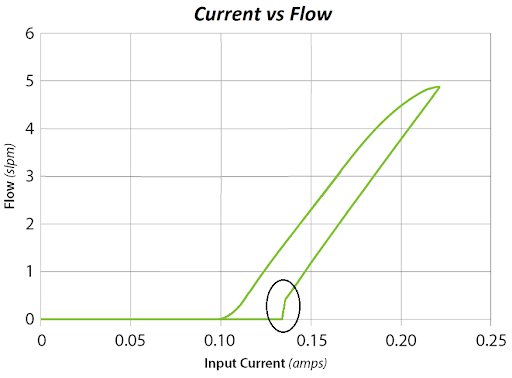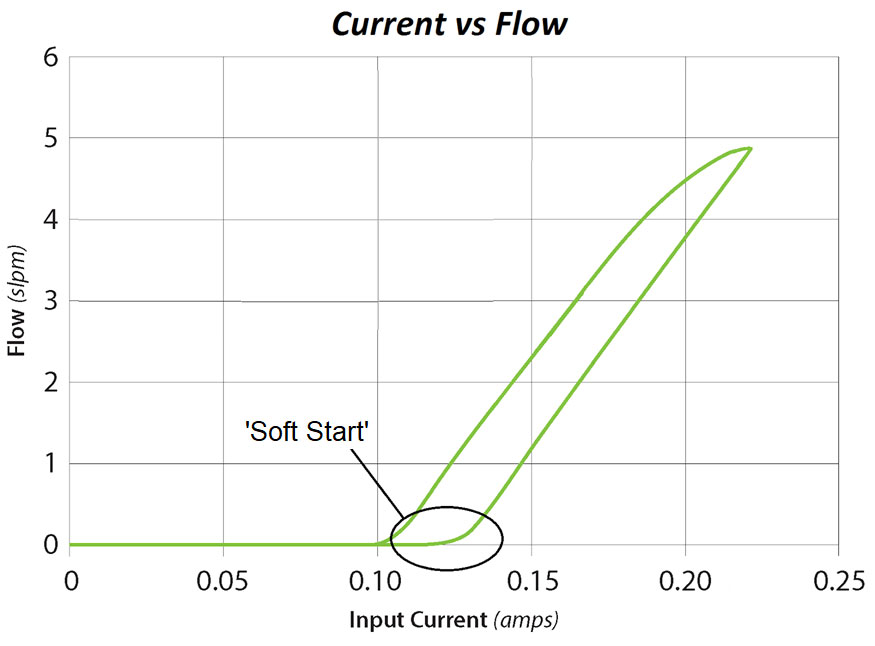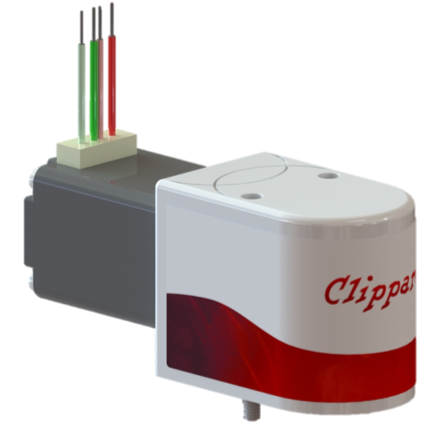The Importance of a Soft Start for Critical Applications Requiring High Precision
When a valve is cycled, one can observe the quality of control by measuring and graphing the flow leaving the valve and the input operating the valve, such as electrical current (for coil controlled valves) or steps (for stepper motor controlled valves). This paper will discuss the characteristics of a valve's performance curve—specifically, where flow begins and how the curve's trend can indicate certain valve features and their consequences.
When selecting a valve, there are many parameters to look at, but when sensitive equipment is involved and precision is vital to the application, such as in fluid analyses, characteristics of the flow's lift-off should be considered because initial flow can have a startling impact on the life and operation of the system overall. For example, if a valve allows an abrupt surge of flow, it can cause hydraulic shock (also referred to as water or fluid hammer). This can be seen in Diagram 1 where the circled area shows a sharp spike of flow occurring at the lift-off or opening of the valve.
Common Causes of Abrupt Lift-Offs
Abrupt lift-offs are typically due to how the internal sealing surface of the inlet (usually a nozzle) engages with the actuating sealing surface of the valve, which—most commonly—is a poppet with rubber adhered to its surface. Unfortunately, the nature of rubber (Viton, EPDM, etc.) lends itself to sticking, deformation, and degradation, which in certain circumstances results in the poppet clinging to the nozzle before sharply disengaging. Mechanical irregularities can also cause or contribute to a sudden increase in flow, but those are very specific to the design of the valve, such as spring or even frictional forces.
Certain types of valves have characteristics that make them better suited for reducing flow lift off or surge and hammer, such as gate valves, ball valves, or needle valves. To limit in-rush flow in your application, the valve's working orifice needs to be variable in its free area. A typical control valve, such as a poppet or spool valve, has a fixed orifice and therefore, lift on the seal face is working across the entire circumference of the orifice. This results in an initial spike in flow. For example, a 0.006 orifice with a 0.001 controlled lift would represent 6.5% full flow, equivalent to an abrupt lift-off or jump.
Flow Impact on System and Application
Hydraulic shock can result in vibrations, noise, and even pipe or seal rupture/failure. For sensitive systems especially, ensuring a smooth, consistent lift-off of flow is key, and not just for the life or maintenance schedule of the machine. Sudden changes in flow, however brief, can be especially detrimental and costly in control-critical applications, like medication or ventilation control, but also in instances where instrumentation is utilized to measure aspects of a system, such as miniature blood pressure cuffs. A sudden spike in flow could be too high and fast for a gauge to measure and relay in time, which will result in an inaccurate or incomplete reading.
|
|
||
Diagram 1: Abrupt Lift-Off |
Diagram 2: Soft Start |
|
|
|
||
Flow Impact on Medium
Sharp spikes of flow can also mean premature or excessive amounts of media entering the lines, which for critical applications, such as sample extraction, can waste expensive reagents/solvents or even result in inaccurate analyses. There is also the state of the medium itself to consider, such as blood or other sensitive fluids susceptible to hemolysis or homolytic fission, in which the cells or compounds within the fluid breakdown. Turbulence increases the loosening of chemical bonds, so minimizing disruptions or jolts in the flow will prevent the destruction or ruination of delicate samples. Thus, a valve for delicate applications must provide a flow profile that minimizes turbulent flow—protecting components, internal instrumentation, and fluid composition from damage. To accomplish this, "soft starts" are recommended (see Diagram 2). Unlike the prior lift-offs shown, a "soft start" provides a gentle introduction of flow before smoothly easing into a proportional flow rate (per current or steps provided).
Curve Consistency
Ensuring the flow curve follows the same trend valve-to-valve, especially lift-off characteristics, is important for consistency in production and for creating confidence in the product; after all, superior, low end control that allows microliters of flow is only superior if it is repeatable. However, one must also acknowledge that no two valves will perform exactly the same because no two can be perfectly identical; thus, there should be a range in which all valves will operate within instead. When selecting a valve, this range should be known and understood so that all valves within any given batch are adequately uniform and can operate as expected in a given application. This can concern lift-offs especially.
Therefore, whenever selecting a valve, it is important to be mindful of the valve's lift-off characteristics and consider whether or not it will support or hinder the application.
By Jess Koeniguer • Design Engineer • Clippard
|
Related Products |
||||
|
Eclipse Proportional Isolation Valve  |
||||





